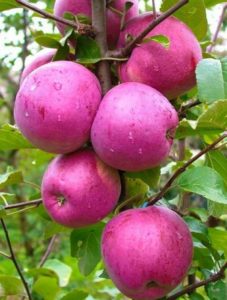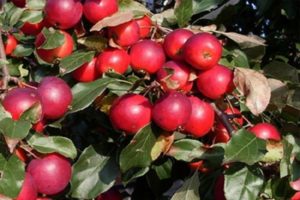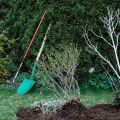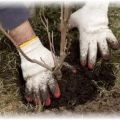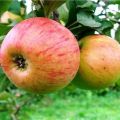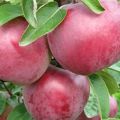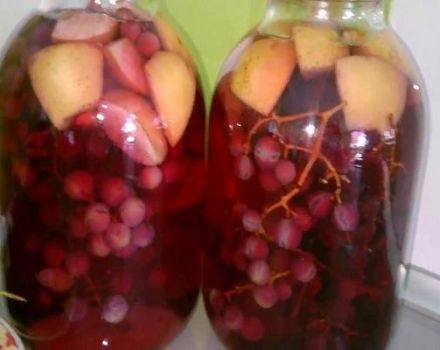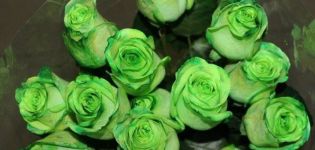Description and characteristics of the summer variety of Mantet apple trees, planting and growing rules
The Mantet apple tree was bred by Canadian breeders in 1928. The variety is hybrid, obtained by natural pollination of Grushovka Moskovskaya. Mantet is included in the State Register of Fruit Trees for the Central and Middle Volga Regions of Russia.
Description and characteristics of the variety
The variety is thermophilic, hardly tolerates frosts. With minor frostbite, it quickly recovers. Requires methodical care. Like any summer variety, it does not differ in the keeping quality of the crop.
Tree height
The average adult Mantet apple tree does not exceed 4.5 meters. The trunk is crowned with a round crown, of medium density, not subject to strong thickening.
Bloom
The inflorescences consist of white flowers with rounded, slightly elongated petals, a short pistil and stigmas located below the anthers.
The petals are pinkish, turning into purple (closer to the middle of the flower).
Leaves
Leathery, with a glossy surface, large dark green leaves. The shape is oval, the tip of the sheet is pointed, the edges are wavy, raised, reminiscent of the cutting edge of a metal file. Veins are lighter than the main color of the leaf. The peculiarity of the Mantet foliage is that a leaf and thin stipules emerge from one pubescent bud.

Crown
The crown of Mantet consists of several types of branches:
- Biennial and earlier shoots stretch almost vertically towards the sun.
- Cranked shoots differ in brown color.
- The short lentils have a gray bark.
In adult Mantet apple trees, the branches are hardy, and the bark is quite dense, which cannot be said about young trees.
Fruit
A cone-shaped apple of regular shape weighing from 90 to 180 g is distinguished by pronounced ribbing of the upper and lower parts, the middle part is smooth. The seeds of a mature fruit are dark brown in color, their shape is triangular, and the silhouette is rounded. The peel is smooth, dense, thin yellowish-green, the blush on these apples is manifested by bright red spots, vertical stripes. Juicy creamy pulp, possibly greenish, pink shades at different stages of fruit ripeness.

Tasting assessment
The taste is sweet, slightly sour without aroma, and was rated 4.4-4.6 points out of 5 possible.
Harvest ripening time
Fruit ripening is uneven, the first fruits in the southern regions can be harvested in mid-July.In the middle lane, it will be possible to enjoy dessert sweet apples only in late July - early August. The last fruits are harvested from Mantet apple trees in the first half of September.
Yield
At the first fruiting, which occurs in the 3rd season after planting, it can reach 20 kg. With proper care, the harvest will become richer every year. From an adult plant over 10 years old, 70 kg of fruits are harvested. Mantet bears fruit for half a century.
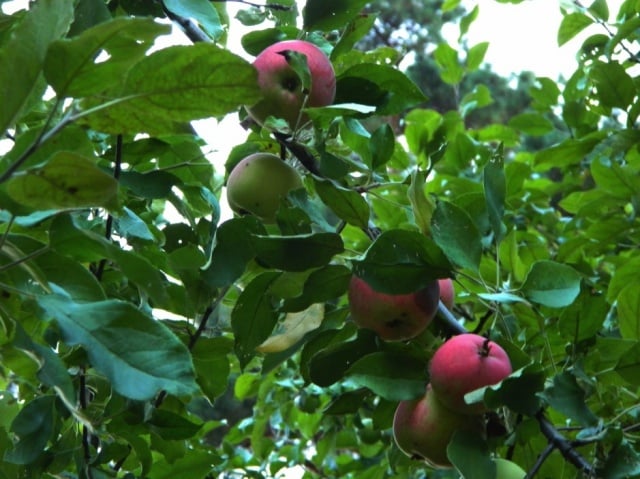
Winter hardiness
The winter hardiness of the Mantet apple tree is not designed for planting in regions with severe winters. It does not always come out without losses after frost -18 ° C. Where the air temperature can drop below -10 ° C in winter, the apple tree trunk must be securely wrapped, and the plot of land above the root system should be mulched with a thick layer of sawdust and straw.
Disease resistance
The scourge of Mantet apple trees is scab; the apple tree of this variety does not have a strong immunity to other fungal and infectious diseases.
Useful properties of apples
Apple diets or fasting days are recommended even for pregnant women, only 48 kcal, and apples will provide nutrients, fruit fiber, iron, vitamins and minerals for the daily diet in full. The main thing is not to abuse, because there are a lot of sugars in these fruits.
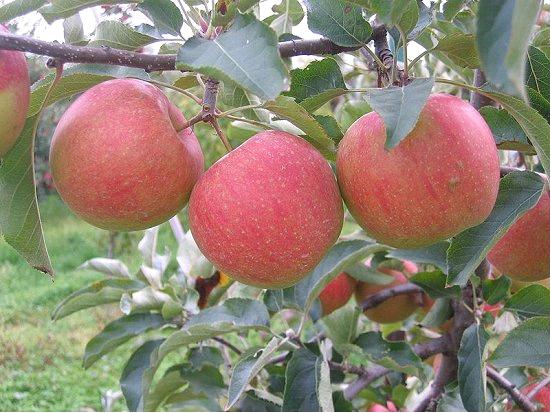
Advantages and disadvantages
The advantages and disadvantages include:
- The dense, neat crown of Mantet does not require close attention.
- The plant is not whimsical in the choice of neighborhoods, flowers and vegetables can be planted next to it.
- Apple trees of other varieties, with which Mantet has the same flowering period, only improve the yield of the self-fertile variety.
- The fruits are delicious.
- After 10-11 fertile seasons, the apple tree will delight with a rich harvest in a year.
- The presence of pollinating apple trees and favorable weather conditions greatly affect the quality of the crop.
- Non-simultaneous ripening of fruits.
- Young, fragile branches of an apple tree break under the weight of the fruit.
- The higher the yield, the smaller the fruit.
- Weak immunity to diseases and attractiveness to pests.
- Low winter hardiness.
- In rainy seasons, the likelihood of scab damage increases.

Landing features
The low winter hardiness of the Mantet apple tree practically reduces its survival rate to zero, if it is planted in autumn in temperate latitudes. The optimal landing date is from 1 to 15 April.
Selection of seedlings
When choosing seedlings, you need to pay attention to:
- strongly pronounced stem;
- the presence of 3-5 flexible branches with a length of 50 cm;
- evenness, uniformity of the bark;
- the health of the root system, consisting of skeletal and kidney 30-cm roots.
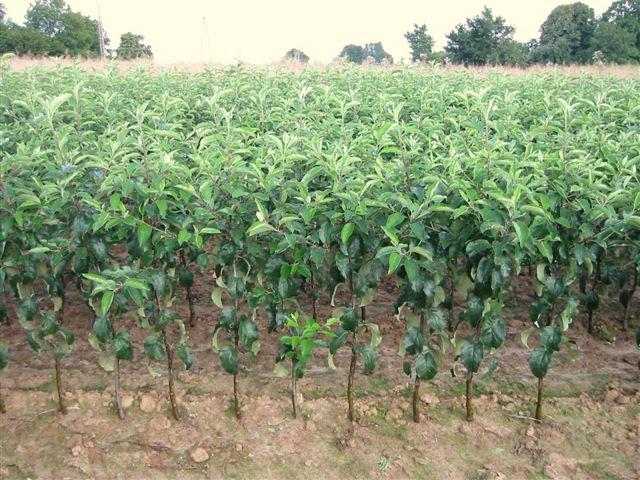
Time and place
The best soil for the Mantet apple tree is loam in a place protected from strong winds. Sunlight should easily penetrate the plant, and groundwater should not come into contact with the roots. If there is no way to find a more favorable place, then it is necessary to provide the plant with high-quality drainage.
Planting pit preparation
A hole for an apple tree seedling must be prepared in advance - from autumn or 2 weeks before planting. Its width and depth are ≈ 100 cm. Part of the selected soil is mixed with humus, wood ash, potassium sulfate, superphosphate. This enriched pillow is backfilled with a layer of 20-30 cm. It must be separated from direct contact with the roots with a layer of fertile soil. All this is filled with 10 liters of water. A stake is driven into the middle, it will be needed to tie the seedling.

Landing scheme
The gap between Mantet trees is at least 3 meters. The seedling is lowered into the hole parallel to the peg, its roots are neatly distributed over the earthen cushion. Care should be taken that after filling the hole with earth, the bole rises 5-7 cm above it. The plant is tied up, it needs an additional axis in the first two years after transplantation.
After planting, you should make a circular ditch at a short distance from the trunk and water it. Each seedling requires 30 liters of water.
The nuances of care
The Mantet variety is sensitive to both drought and waterlogging. In the absence of natural precipitation, an irrigation system should be considered, because each adult tree may require from 70 to 120 liters of water during the flowering period, and when fruit juices are poured, this rate doubles.

Watering and weeding
High-quality soil moisture in the Mantet apple tree is recommended at least 4 times per season:
- before flowering;
- in mid-June;
- in July at the stage of fruit ripening;
- in mid-October.
After each watering, the soil adjacent to the apple tree trunk must be loosened and, along the way, cleaned of fallen leaves, dry branches and other debris, and the soil must be mulched again.
Pests
Apple mite, leafworm, aphid, moth. To combat them, infusions of onion peels, bitter wormwood and spraying with chemicals, carried out until flowering, are suitable.
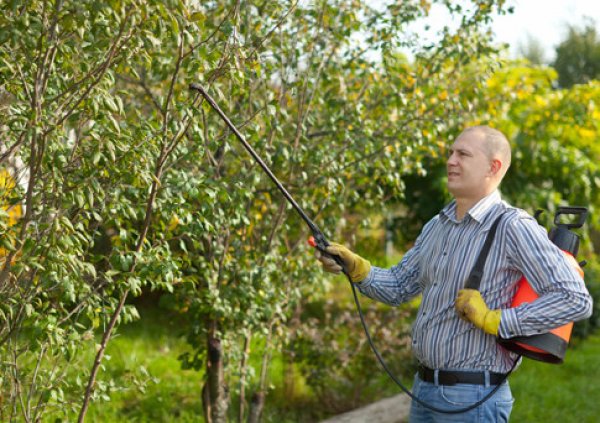
Pruning
Scheduled pruning of Mantet apple trees is done in early spring and after harvest. At these stages, frozen, dried, old branches are removed. In the summer, you need to remove unwanted shoots that take away the juices of the fruit tree. The roundness of the crown is also maintained through systematic pruning.
Top dressing
To accelerate the rooting, the formation of skeletal branches, the approximation of the fruiting dates of apple trees, root dressings are used. Dry fertilizers are applied to well-moistened soil. Liquid products are easier for a tree to absorb from dry soil:
- For the April top dressing, 500 g of dry urea is enough, it is distributed around the tree trunk within a radius of 50-70 cm from the trunk.
- When watering prior to flowering, it is recommended to apply organic fertilizer - manure diluted so as not to overfeed or burn the apple tree. For a young seedling, 30 liters is enough, an adult plant needs 100 liters of nutrient fluid.
- In the process of loosening the soil, compost is applied to the apple tree.
- In mid-May, a complex feeding is required, consisting of: 7 liters of water, 35 g of potassium sulfate, 200 g of superphosphate, 330 ml of guano infusion.
- 600 g of urea is redistributed over the area next to the tree trunk at the end of May after preliminary high-quality soil moistening.
- To obtain a high-quality harvest in mid-June, fertilizing from 600 g of nitrophoska and 5 g of sodium humate, diluted in 20 liters of water, is required.
- After harvesting, 350 g of superphosphate and potassium sulfate are distributed over the soil around the trunk.

Whitewashing and preparation for winter
Whitewashing is the protection of the trunk from freezing, rodents, insects that are not averse to settling in the bark of an apple tree. Such complex protection will be provided by lime whitewash, enriched with clay, copper sulfate.
To insulate the apple tree trunk, any available material of natural origin is used - hay, straw, reeds, sunflower greens, they are wrapped around the trunk and lower branches.
The outer layer, which protects natural insulation and apple trees from getting wet, respectively, should be roofing material. For even more reliable protection of the plant, it is recommended to pour a peat cover 20-30 cm thick on the root zone. In winter, a thick layer of snow also reduces the risk of roots freezing.
Collection and storage
Harvested from Mantet apple trees due to the non-simultaneous ripening of the fruits of this variety from July 15 to the first ten days of September. At a positive storage temperature, apples retain their presentation and original taste for no more than 2 weeks from the moment they were removed from the tree. In the refrigerator, apples are stored for 3-3.5 weeks. Fallen fruits spoil faster.
